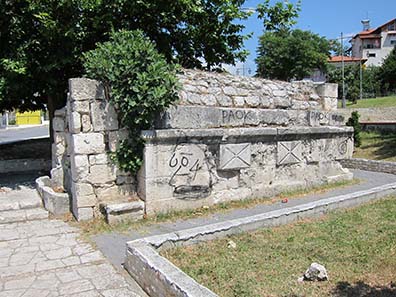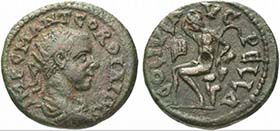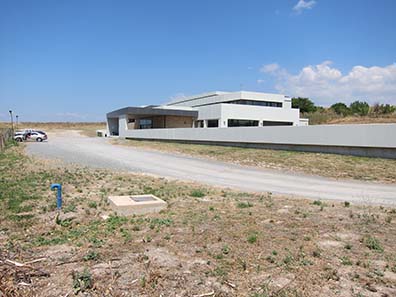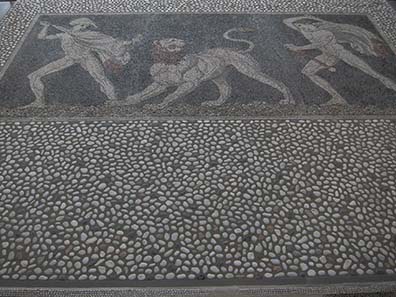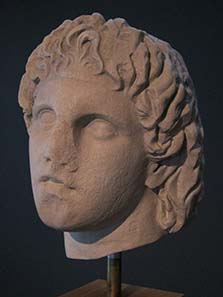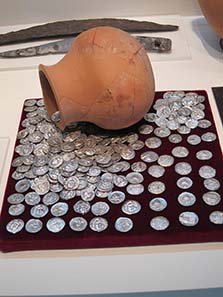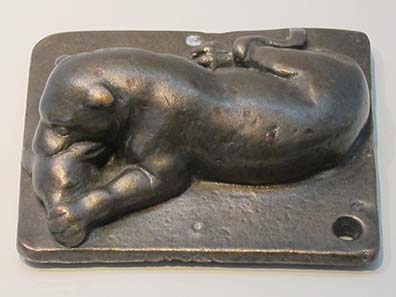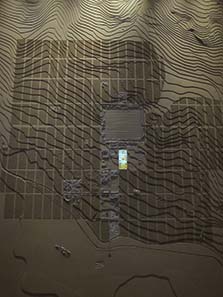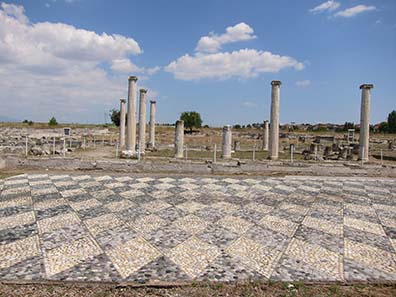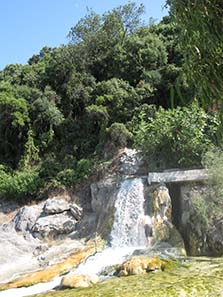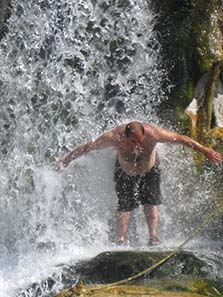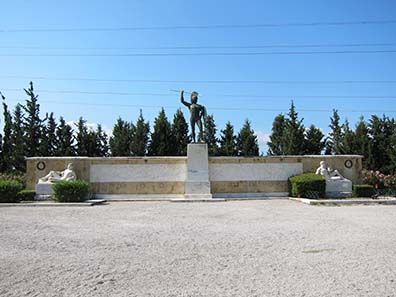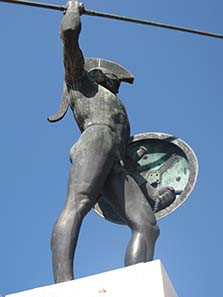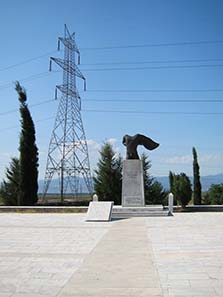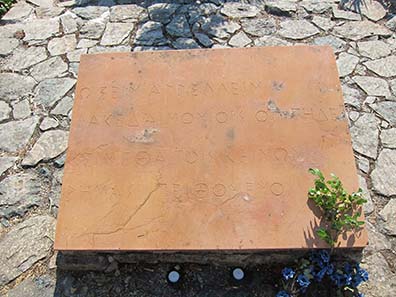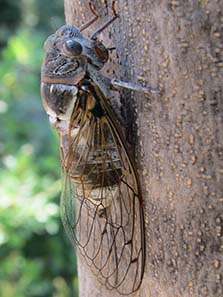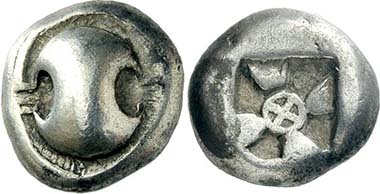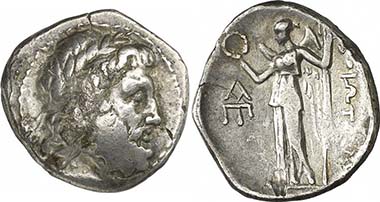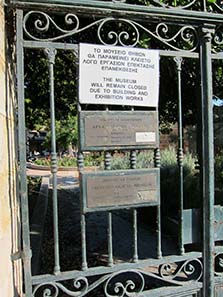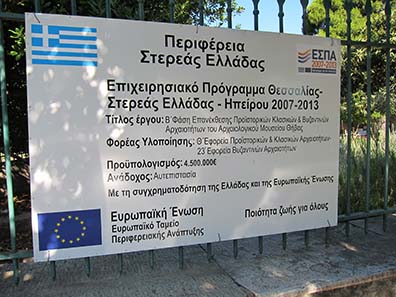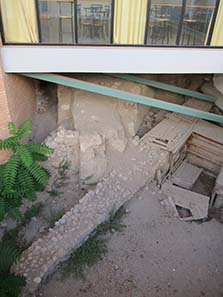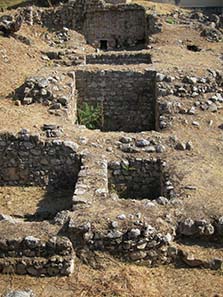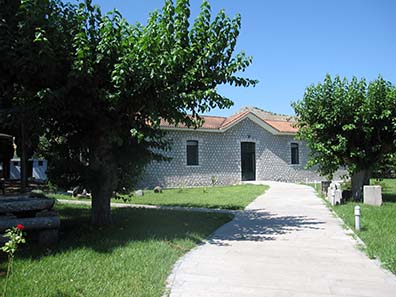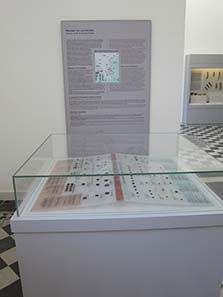by Ursula Kampmann
September 15, 2011 – Our journey home from Northern Greece to Loerrach took six days – and it was an adventure. This is part one, from Macedonia to Delphi: we visit Pella, suffer a Greek village festival and arrive at the hot sources at the Thermopylae. In addition, Thebes and Chaironea are on our agenda…
Day 27, July 7, 2011, Heading South
After 27 days, the time had come. We definitively had to go home. We did it being completely overtired. A group of juveniles had stayed in our hotel and these young people had a somewhat different idea about what to do at night. Being drunk, they returned to the hotel at 3 a.m. from their night out. After they had waken everybody they resumed the tour. After their second return in hit-and-run-style we were fed up. We got up and waited for our breakfast in front of our hotel in order to leave this inhospitable place as soon as possible.
By the way, the squad had stayed in the hotel at a preferential price. They were members of a sports team about to enter a sailing contest the following day. I hope that lost big-time.
Modern statue of Alexander the Great in Pella. Photograph: KW.
Our first destination was Pella, where the royal court of the Macedonians had been situated. Originally, the city was placed nearer to the sea when Archelaos (431-399) transferred his residency here. Pella soon became the most important city of Macedonia.
Ancient tomb in the city center. Photograph: KW.
It was here where Archelaos accommodated Euripides and Agathon. The painter Zeuxis decorated the walls of the royal palace. Philipp II received the Athenian representatives Aischines and Demosthenes in Pella in 346 for negotiations. Until Macedonia was defeated near Pydna, Pella remained the center of the empire.
Pella. Gordian III. Bronze. Rev. COL IVL AVG PELLA Enthroned Pan l. From auction Münzen und Medaillen GmbH 13 (2003), 93.
After that, decline was imminent. The govenor resided in Thessaloniki, and the city’s population had diminished to such an extent that Augustus founded a Roman colony here called Iulia Augusta Pella from which quite a number of coins have come down to us. The city managed to hold its ground for some time, but the surrounding marshes were the reasons why the city was visited by the Malaria time and again. Already in Slavic times, only the term ‘bath of Alexander’ recalled the former capital of Macedonia.
A museum in the middle of nowhere. Photograph: KW.
Today, the magnificent museum in the middle of nowhere, on the fringes of the city, is supposed to attract tourists. It looks as if a UFO had landed – alien is the impression the modern architecture makes in the middle of the rather poor village. Step by step, all the wonderful mosaics of Pella are relocated here. Some have already arrived in the museum while others still attract a few visitors to the archaeological excavations.
Representational mosaic made of pebble stones. Photograph: KW.
The mosaics are the highlight of the museum. The artistic skill of the craftsmen creating realistic sceneries with only the few tints of the pebble stones is incredible. The hunting scene with two men stalemating a lion is second to none. The colors appear even brighter when water or oil is spilled on the mosaic – it is very likely that this was daily routine of the servants back then.
Portrait of Alexander. Photograph: KW.
Another highlight is a portrait of young Alexander that is said to date to the 3rd cent. B. C.
Find of Macedonian coins and drachmae of Rhodian Peraia. Photograph: KW.
There are plenty of coins to see in the museum. The reason for this is the obvious problem of the ones in charge with filling their a bit oversized museum with exhibits (at present, the second floor is still completely empty).
Hoard find whose display takes much space in the showcase on the wall. Photograph: KW.
Hence, it was decided to present a number of hoard finds in a showcase in such a way that each coin lies in a huge blank area. Although the picture of course doesn’t reveal it: the coins on display are for the most part pieces of the same type, mounted all side by side and with much space between them.
Weight. Photograph: KW.
Of course there were not only coins and mosaics to view but quite a number of nice exhibits which truly are worth a visit. We were deeply pleased with that and hence decided – for we are quite unconventional – to turn around at the end of the exhibition to have a second look at the most beautiful objects. What we didn’t take into account, however, were the sharp eyes of the guard. This was one-way traffic and by we were no means allowed to walk in the opposite direction. I would have understood had it not been for the fact that only 12 visitors were present in the entire museum. Thus, the risk of causing a traffic jam was pretty low. I pointed that out and the guard left us to our fate, grudgingly.
City map of Pella. Photograph: KW.
Ancient Pella must have had an enormous size. Only a tiny area is excavated the Greek administration of antiquities presumably has something really big in mind with. The pavilions erected for the museum educational service and the sale of souvenirs are almost bigger than the archaeological site. It is a pity that the number of visitors doesn’t keep up (yet) with that. We were the only ones on the area.
The ruins of Pella. Photograph: KW.
To be honest, we didn’t really enjoy our stay. It was simply too hot. The ruins were impressive but not incomparable. It is easy to become arrogant when traveling through Greece for four weeks and seeing many spectacular things. In short, after an explanatory walk we went on the run. After all, we had a long drive ahead!
Thermopylae of course derives from thermos, warm, and pyle, gate. Photograph: KW.
Did you ever wonder about the origin of the word Thermopylae? Thermos means warm (just think of the thermos jug) and pyle means gate since the Greeks considered the smelly sulfur springs emanating here the entrance to Hades.
Taking a bath in the sulfur springs has a positive effect on rheumatism. Photograph: KW.
Today, they are the real attraction and hugely popular with the local inhabitants. Over the course of half an hour, when we had a break, again and again – prime-aged, as it were – men came here to shower their painful limbs with the bubbly water. In order to do so, they had to manage a rather dangerous course over an unsteady lattice and an unsecured rock which they did, demonstrating elegance and experience.
Monument reminding of the Battle of Thermopylae. Photograph: KW.
Only a few crazy people like us stop at the modern monument 300 Spartans living abroad had erected in 1955 in honor of Leonidas. Today, it is situated off the street because the recently built railway to Athens has marginalized the old ordinary road, much to the benefit of the idyll of the place.
Site plan of Themopylae at the time the famous battle took place. Photograph: KW.
The date was 480 B. C. when a Greek army, led by the Spartans, confronted the Persian invaders under Xerxes. The Greeks managed to hold their ground for two days before a traitor showed the Persians the mule track over the mountains enabling them to evade the Greek position. While the main force withdrew to resume the fight later, 300 Spartiates and 700 Thespians and Thebans covered their retreat. In contrast to the Thebans who surrendered, the Spartiates and Thebans fight till death. For Sparta, this sacrifice paid off. Thanks to it, its warriors gained immortal glory of always holding their ground.
Leonidas. His statue decorated the modern monument. Photograph: KW.
Due to its special location, Thermopylae became the scene of numerous battles. In 279 B. C., Kallipos fought the Galatians here – without success, though; they were to loot the sanctuary of Delphi later. In 191, the Romans defeated Antiochos III, and the Visigoths under Alaric met no considerable resistance when they passed Thermopylae in 395.
Monument for a very different battle. Photograph: KW.
A second monument – unfortunately, its inscription is in Greek only – is devoted to the Battle of Thermopylae of April 24-25, 1941. The Allied Forced had to withdraw from Greece while the Germans advanced from Northern Greece to the South. Australians and New Zealanders managed to hold Thermopylae for one day enabling the British headquarters to evacuate its troops in time. Unfortunately, the dignity of both memorial sites is impaired by a huge power pole towering over the monuments.
Wanderer, if you come to Sparta. Photograph: KW.
How moody, in contrast, is the slab placed that shows the well-known inscription: “Wanderer, if you come to Sparta, report thither that you have seen me lying here, as the law commanded.” Incidentally, we had spilled blood either. The thorns of the wild oak twig were pretty sharp.
Cicada. Photograph: KW.
The hill is quite deserted where Leonidas last haven presumably was situated. Only the cicadas sing their song, and the world seems far, far away.
We were honestly tired. First, however, a quarter for the night had to be found. We wanted it to be quiet. After all, we had barely slept the night before. The search went on for hours. Again and again we drove downhill to the beach-resorts to discover only condominiums and villas there but no hotels whatsoever – and on we went. The paths we were forced to drive on hardly deserve to be called streets. Bit by bit, our car held that against us. The cooling was growing louder, and the temperature rose. It started to become very, very uncomfortable. Plus, it was way past eight. When we finally reached a hotel we didn’t give it any consideration but immediately booked a room – a mistake as it turned out during the night.
Well, we have become modest by now. The shower being a hose plus a hole in the floor? No problem. Tired as we were, we certainly could live with the saggy beds. The only thing that troubled us for a short period of time was that the air condition didn’t transport the condensed water outside but dropped it over the television set and the fridge. Consequently, we put our belongings on the shaky table, unplugged fridge and telly to avoid a short circuit and sank onto the beds, being really exhausted.
Around 10 p.m., we awoke again. Someone next door seemed to have turned the radio to full volume. What does radio mean? Soon we felt like onlookers of a rock concert Greek style. No break, without interruption the loudspeakers made such a noise that there was no way of getting some sleep. Not even the (loud) air condition drowned out the noise. We kept a stiff upper lip until 6 a.m. until we finally gave up. We packed our things and left. At the reception we asked what that had been all about. Well, once a year a festivity was celebrated in honor of a saint. Which one? The hostess didn’t have a clue.
Remains of the party. Some men danced still, and the music was playing at full volume. Photograph: KW.
When we left the village, feeling absolutely whacked, a couple of inexhaustible men danced still. The name of the place? No idea, we gave it the oblivion.
Day 28, July 8, 2011, From Thebes to Delphi
First thing we desperately needed was a real good coffee and a tea for me, respectively. We decided to pay a visit on the former major power, Thebes.
Thebes. Drachme, 480-460. From auction Numismatik Lanz 151 (2011), 395.
Thebes ranges amongst the particularly awe-inspiring places in Greece closely linked to Greek mythology. Legend has it that Kadmos, brother of Europa, had founded Thebes when searching for his sister. This is the setting of the history of Oedipus who married his own mother after killing his father.
Thebes. Stater, c. 426-395. Rev. Dionysos. From auction Gorny & Mosch 195 (2011), 167. – The club on the obverse is indicative of Herakles, the reverse of Dionysos.
Thebes is considered birthplace of Herakles and Dionysos. It experienced its golden age, however, only after the end of the Peloponnesian War that had weakened the two big powers, Sparta and Athens, considerably. Against expectations, the Battle of Leuktra in 371 B. C., was won by Thebes. Thanks to Epaminondas and his ‘oblique formation’ it managed to defeat the Spartans which had hitherto regarded invincible!
Thebes. Stater, 379-338. From auction Gorny & Mosch 195 (2011), 166. Photograph: KW.
The bloom of Thebes, however, didn’t last long. The Thebans had to surrender to the rising Macedonian power already in 338. The Battle of Chaironea spelled the former’s doom. Macedonian occupying troops were stationed in the citadel of Thebes. After the death of Philipp, Thebes started a final attempt to regain its autonomy. Alexander punished it relentlessly. He conquered the city in 335 and ordered it to be destroyed. Only the Diadoch Kassander allowed a rebuilding of the city.
Thebes. Drachme, c. 196-146. From auction Gorny & Mosch 186 (2010), 1305.
Thebes’ power was gone for good when the Romans annulled the Boiotian League in 146 B. C. Thebes continued to be a flourishing provincial town without greater significance where Christians are said to have settled relatively soon. After all, good legends have it that already under Domitian a bishop of Thebes had to die a martyr’s death. In Byzantine times, Thebes became a center in Central Greece, renowned for its silk weaving and the dye-works with purple. Roger II relocated the silk weaver here which made Palermo the new home of that skill.
After endless fights, the Turks conquered the city for good in 1460; it was one of the places most fiercely fought over during the Greek Civil War. That and two earthquakes, in 1853 and 1893, destroyed much of the buildings.
Pedestrian zone of Thebes early in the morning. Photograph: KW.
Today, Thebes is a small hicksville with a nice pedestrian zone. Hardly any tourist visits it which is easy to understand.
Archaeological Museum of Thebes. Photograph: KW.
The Archaeological Museum of Thebes – as the city’s only thing an art guidebook recommends – is closed for alterations.
Construction board at the Museum of Thebes. Photograph: KW.
The alterations will cost 4.5 million Euros. As customary in Greece, the European Union will bear the bigger part of the costs, probably in the hope that that will boost tourism.
“Depot” of the Museum of Theben. Photograph: KW.
But what will happen to the ancient remains being stored on the opposite plot? Not that it might be important, in view of their scientific significance…
Unexplained ruins underneath a modern cultural center. Photograph: KW.
Let’s hope for the ones in charge to find a better solution than with these unexplained ruins that had been integrated in a cultural center? What the former building had been exactly? Oh, I don’t know, the dusty ruins didn’t whet my interest in any case.
Explanatory board to the Theban Kadmeia. Photograph: KW.
In contrast to this explanatory board to the Kadmeia. This is the legendary citadel of Thebes that was named after Kadmos. The Achaeans had immigrated to Greece in the second half of the 2nd millennium B. C. and subjugated the local population. They had sophisticated technology at their disposal which they used to build a canal system in Boeotia that still fascinates the modern viewer. They were the ones who laid out a representative residence whose remains are presented today as Kadmeia.
Kadmeia – the archaeological excavation. Photograph: KW.
It is possible to look at the excavation site from above. We were the only ones doing so, much to the astonishment of the locals. By their amazement at it, it seems safe to assume that not many tourists come by.
Rubbish sacks on the site. Photograph: KW.
Probably for the very same reason it is considered unnecessary to remove the rubbish sacks which evidently lie around here for weeks already. Once again, we had enough. We wanted to leave that place, arrive at a beautiful hotel, with no noisy music, no matter the costs.
The Lion of Chaironea. Photograph: KW.
When heading for Delphi we noticed a sign pointing out that this was the exit ramp leading to the place of the Battle of Chaironea. It was an unusual sign: colorful so that one felt like visiting the spot.
That was a blessing. Apparently, the city administration had put some effort in making their place livable. A man was seen from afar who maintained the grounds. We were led to a big, fully constructed parking area from where it is only a stone’s throw away to the Lion of Chaironea that had been erected by the Thebans once to remind of their fallen comrades. The area was tidy and devoid of disgusting empty plastic bottles. Only the lion appeared somewhat crumpled. Hardly surprising – it had been blown up in 1800 on the wrong assumption that there was a treasure hidden it its pedestal. What is on display in Chaironea today had been reconstructed from the pieces.
The small Museum of Chaironea. Photograph: KW.
Not far from the lion the Museum of Chaironea is situated where we once again had the pleasure of realizing the importance of a careful museum guard for the well-being of the visitors. Once we had passed the door we were welcomed and asked politely if we wanted to watch a film on the history of the spot. Of course we wanted. And we readily appreciated the guard immediately dragging two of his own chairs close to that we would feel comfortable in front of the screen.
Found from the mass grave of the Macedonians. Photograph: KW.
Admittedly, I have seen museum with more impressive finds but it was moving nevertheless to see the remains from the mass graves in which the ones killed in the Battle of Chaironea were buried.
Showcase with coins in the Museum of Chaironea. Photograph: KW.
Of course, they had coins there, too. I don’t want to miss the opportunity to warmly recommend the small Museum of Chaironea to all travelers to Greece.
Monastery of Hosios Loukas. Photograph: KW.
After a little detour – not related to numismatics – to Hosios Lukas it finally happened: our car finally had enough of heat, mountains, driving slowly, uphill and downhill. It went on strike. After just a few seconds the thermostat had reached the red area. We were at a dead end. We were standing on the street, were annoyed and forced to wait for the car to cool down again.
The further kilometers we drove on eggshells. Every gradient frightened us. And there was me striking on the idea of taking quarter not in Delphi but in the skiing resort Arachova. 50% of the hotels were closed. Finally we found one open, a five star hotel guarded by a single man. The five stars were Greek ones but the prices corresponded to that. And the room made our most inner wishes coming true. It was tidy, cool and had a decent shower cabin, in short: a dream. We diced to spend our last days here to go easy on the car. After all, we didn’t want to be forced to repair it while still in Greece.
Read about our visit to Delphi and the new port of Patras in the upcoming and final issue of the numismatic diary.
You can read all other parts of this diary here.





